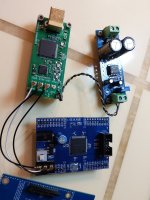@eclipsevl,
good option and one can improve the reclocking later by your aditional board to choose his own clock for fanatics like I or @zoom777 who has used your board with good results 🙂
Btw, have you comunicated with Thorsten Loesch for an iterration for the tda1541A sim logic and timing TDA1541A specs with no clock stop ? I saw you had few echange in a thread ?
good option and one can improve the reclocking later by your aditional board to choose his own clock for fanatics like I or @zoom777 who has used your board with good results 🙂
Btw, have you comunicated with Thorsten Loesch for an iterration for the tda1541A sim logic and timing TDA1541A specs with no clock stop ? I saw you had few echange in a thread ?
Last edited:
The most instant solution is York then.
Would you tell us the reason? With a cause, suggestions would be more constructive, I think.I don't want to go the route to use the JLSound boards.
It is not especially cheap when you add the VAT of board and shipment inside the EU and support is so-so I discovered few time ago, was disapointed with that, so they have not my monney anymore despite I bougth two.
Going the JLSound route is going to cost a bit here in Europe.Would you tell us the reason? With a cause, suggestions would be more constructive, I think.
Amanero, u30 or others will be a more "not brand" specific solution.
I soldered some op-amps on DIP8 board. The one with flux was the one who failed. Flux going under the chip and made it work very unstable.
The one where I soldered just one leg first to position it properly worked best for me.
I just don't see myself doing so many big chips on a bigger board.
The pre-made CPLD board from a few post ago would be my choice.Hi,
AD1862 is no I2S input compatible so you need logic after I2S output boards like Amanero is.
Miro's cpld is an option as the offers here of I2S to AD1862 diy pcb boards already soldered.. But if you're afraid to solder the shift registers, be aware the cpld is way tinnier and harder to soldering. So go for an already soldered board instead a raw board to populate.
There is not particular difficulty with the shift-registers. You just need using flux and magnyfing glass and look at some Youtube soldering HOW TOs.
Be aware too, Amanero's clones are not very good on the clock quality.
And of course, Amanero clone + CPLD board recommended by Miro is the most economical solution. Once you make sure they have proper power supply instead of drawing power from the USB bus, the result can be very satisfying.
That looks like a good solution.And of course, Amanero clone + CPLD board recommended by Miro is the most economical solution. Once you make sure they have proper power supply instead of drawing power from the USB bus, the result can be very satisfying.
Is it possible to use the AD1862 digital 5V as input without degrading the quality
For the flux, when few pins on an ic, I sligthy bend the legs down by putting a layer of plastic sheet below the body. In order all the legs are at the same level but the ic bully doesn't touch the pcb for proper washing and cooling when on the pcb. Dunno if it works but I better sleep with high speed ICs.
The one with flux was the one who failed. Flux going under the chip and made it work very unstable.
What flux did you use?
Alex.
Yes, it is possible if your PSU is rated with suitable power to supply the CPLD board and AD1862 digital section.That looks like a good solution.
Is it possible to use the AD1862 digital 5V as input without degrading the quality
Personally, I have tried feeding a separate supply to either the shift registers , the CPLD board, both the JLSOUNDs/York XO + reclock section by removing the zero ohm jumper from +VD to the CPLD. I do not observe any advantage in doing so... Perhaps my ears are not good enough to hear the difference. So I ended up powering all these front end peripherals from the +5VD.
Don't know what is it.
Perhaps a very aggressive acid flux?
"Regular" fluxes, especially "NC" ("No Clean"), I have never seen that lead to unstable operation of the OP Amp (unless 10-50 MOhm resistors in FB, which I believe is not in this case)..
Even chinese clones of 223, 559, etc.
Alex.
I really don't think it is the correct product to use on our boards.
What i found from google :
"Yes, S-39 plumbing flux, while designed for plumbing applications, is both corrosive and conductive, and therefore not suitable for use in electronics. "
Last edited:
It is not especially cheap when you add the VAT
If you know of a different usb solution matching or exceeding the sonic performance and flexibility of JLSound, please don't keep it secret.
At the time i could not find any, today things may have changed.
Isn't York flexible enough? 🙂If you know of a different usb solution matching or exceeding the sonic performance and flexibility of JLSound, please don't keep it secret.
At the time i could not find any, today things may have changed.
This is no secret and is more flexible than JLSound:If you know of a different usb solution matching or exceeding the sonic performance and flexibility of JLSound, please don't keep it secret.
https://www.diyaudio.com/community/threads/diy-stm32-usb-i2s-multichannel-board.425257/post-7959052
- Home
- Source & Line
- Digital Line Level
- DAC AD1862: Almost THT, I2S input, NOS, R-2R
